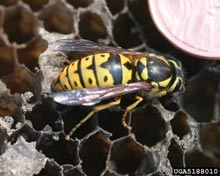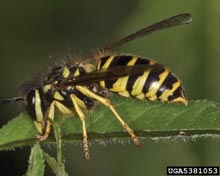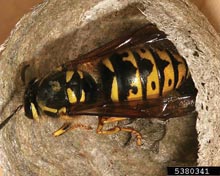
Whitney Crenshaw, Colorado State University

David Cappaert , Michigan State University

Gary Alpert, Harvard University
Yellowjackets
General Description
Notoriously aggressive, the half-inch long yellowjacket has a shiny yellow and black marked abdomen. Often
mistakenly called “bees,” yellowjackets are in fact wasps. They construct paper nests up to several feet across
that containcombs arranged like the floors of a building covered by a papery envelope. As many as 3,000 (many
more in warmer states) can be present in the yellow jacket colony. Nests of the eastern yellowjacket (Vespula
maculifrons) are located in the ground, while the German yellowjacket (Paravespula germanica) nests in
cavities including crawlspaces, attics and wall voids. Adults consume nectar and sweets, but feed their larvae on
captured insects. When temperatures cool in late summer, yellowjacket numbers peak just as their insect food
supply begins to decline. They scavenge more aggressively at this time, taking food from trash containers and
picnickers. When disturbed, yellowjackets can sting repeatedly.
General Control
Sometimes, yellowjackets nest in voids such as vents, attics, crawlspaces or hollow walls. Destroying nests in
these locations can be difficult, often requiring the services of pest management professionals. Also, be aware
that nests may be located several feet away from the point at which the wasps are entering the structure. Simply
applying pesticides into the entrance holes may not be sufficient. It may be necessary to drill into the structure to
enable injection of pesticides directly into the nest. Entrance holes should never be plugged, even after
treatment, because the wasps will look for other ways to get out of the nest and have been known to chew their
way into living quarters, endangering persons inside. Also, use extreme caution when performing bee/wasp
control from a ladder.









